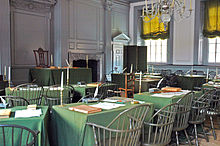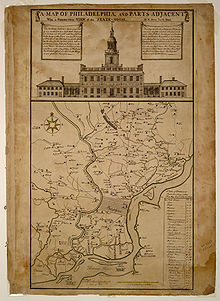Independence Hall: Difference between revisions
Damslerset (talk | contribs) |
Damslerset (talk | contribs) |
||
| Line 45: | Line 45: | ||
[[Richard Henry Lee]] of [[Virginia]] proposed to the [[Continental Congress]] a resolution calling for a [[Declaration of Independence]] on [[June 7]] [[1776]]. The final version of the document is written [[July 2]] (despite minor revisions) and finally, the [[United States Declaration of Independence]] is ratified on [[July 4]] [[1776]] and the new, [[United States]] declares independence from the [[British Empire]]. |
[[Richard Henry Lee]] of [[Virginia]] proposed to the [[Continental Congress]] a resolution calling for a [[Declaration of Independence]] on [[June 7]] [[1776]]. The final version of the document is written [[July 2]] (despite minor revisions) and finally, the [[United States Declaration of Independence]] is ratified on [[July 4]] [[1776]] and the new, [[United States]] declares independence from the [[British Empire]]. |
||
During [[September]] of [[1777]], Philadelphia was occupied by the [[British Army]], and the Continental Congress was forced to abandon the State House and flee to [[York, Pennsylvania]] where [[the Articles of Confederation]]were approved in November of 1777.<ref>[http://uspresidency.com/book President Who/ Forgotten Founders], By [[Stanley L. Klos]] 2004</ref>. The Congress returned on [[July 2]] [[1778]], after the end of the British occupation. |
During [[September]] of [[1777]], Philadelphia was occupied by the [[British Army]], and the Continental Congress was forced to abandon the State House and flee to [[York, Pennsylvania]] where [[the Articles of Confederation]] were approved in November of 1777.<ref>[http://uspresidency.com/book President Who/ Forgotten Founders], By [[Stanley L. Klos]] 2004</ref>. The Congress returned on [[July 2]] [[1778]], after the end of the British occupation. |
||
==U.S. Constitution and the Philadelphia Capital Building== |
==U.S. Constitution and the Philadelphia Capital Building== |
||
Revision as of 01:19, 29 November 2007
| Independence Hall | |
|---|---|
| Location | Philadelphia, Pennsylvania, U.S. |
| Established | 1753 |
| Visitors | 645,564 (in 2005 [4]) |
| Governing body | U.S. National Park Service |
Independence Hall is a U.S. national landmark located inside Philadelphia, Pennsylvania on Chestnut Street between 5th and 6th Streets. Known primarily as the location where the Declaration of Independence was debated and adopted, the building was completed in 1753 as the Pennsylvania State House for the Province of Pennsylvania. It became the meeting place of the Second Continental Congress. The Declaration of Independence, the Articles of Confederation, and United States Constitution were all signed at Independence Hall. The building is now part of the larger Independence National Historical Park and listed as a World Heritage Site.
Independence Hall is a red brick building, built between 1732 and 1753, and designed in the Georgian style by Edmund Woolley and Andrew Hamilton, and built by Woolley. Its building was commissioned by the Pennsylvania colonial legislature and it was initially inhabited by the colonial government of Pennsylvania as their State House. Two smaller buildings adjoin Independence Hall: to the east is Old City Hall, and to the west is Congress Hall. These three buildings are together on a city block known as Independence Square, along with Philosophical Hall, the original home of the American Philosophical Society.
Liberty Bell

The bell tower steeple of Independence Hall was the original home of the "Liberty Bell" and today it holds a "Centennial Bell" that was created for the United States Centennial Exposition in 1876. The original Liberty Bell, with the distinctive crack, is now on display across the street in the Liberty Bell Center. In 1976 Queen Elizabeth II of Great Britain visited Philadelphia and presented a gift to the American people of a replica Bicentennial Bell, which was cast in the same British foundry as the original. This 1976 bell hangs in the modern bell tower located on 3rd Street near Independence Hall.
Declaration of Independence & Second Continental Congress

- Main articles: United States Declaration of Independence and Second Continental Congress
From 1775 to 1783, it served as the principal meeting place of the Second Continental Congress, a body of representatives from each of the thirteen British North American colonies. The Declaration of Independence was approved there on July 4 1776, though the vote was held two days earlier and the Declaration was read aloud to the public in the area now known as Independence Square. This historic document unified the colonies in North America who declared themselves independent of the Kingdom of Great Britain and explained their justifications for doing so. These historic events are celebrated annually with a national holiday for U.S. Independence Day.
On June 14 1775, delegates of the Continental Congress nominated George Washington as commander of the Continental Army—defeating John Hancock in the Assembly Room of Independence Hall. The Second Continental Congress appointed Benjamin Franklin to be the first Postmaster General of what would later become the United States Post Office Department on July 26.

Richard Henry Lee of Virginia proposed to the Continental Congress a resolution calling for a Declaration of Independence on June 7 1776. The final version of the document is written July 2 (despite minor revisions) and finally, the United States Declaration of Independence is ratified on July 4 1776 and the new, United States declares independence from the British Empire.
During September of 1777, Philadelphia was occupied by the British Army, and the Continental Congress was forced to abandon the State House and flee to York, Pennsylvania where the Articles of Confederation were approved in November of 1777.[1]. The Congress returned on July 2 1778, after the end of the British occupation.
U.S. Constitution and the Philadelphia Capital Building

In September 1786, commissioners from five states met in the Annapolis Convention to discuss adjustments to the Articles of Confederation that would improve commerce. They invited state representatives to convene in Philadelphia to discuss improvements to the federal government. After debate, the Congress of the Confederation endorsed the plan to revise the Articles of Confederation on February 21, 1787. Twelve states, Rhode Island being the only exception, accepted this invitation and sent delegates to convene in June 1787 at Independence Hall.
The resolution calling the Convention specified its purpose was to propose amendments to the Articles, but the Convention decided to propose a rewritten Constitution. The Philadelphia Convention voted to keep deliberations secret, and to keep the Hall's windows shut throughout the hot summer. The result was the drafting of a new fundamental government design. On September 17, 1787, the Constitution was completed, and took effect on March 4, 1789, when the new Congress met for the first time in New York's Federal Hall.
In 1790, the Congress moved back into Philadelphia and first met in Congress Hall, mere footsteps away from Independence Hall, on December 6. Philadelphia would remain the seat of the federal government until 1800, where it made its permanent home in Washington, DC. During this time Independence Hall served as the Capitol Building with executive offices, while the Supreme Court assembled in Old City Hall and the Congress continued to meet in Congress Hall.
Recent events
| UNESCO World Heritage Site | |
|---|---|
 View of Independence Hall from the north View of Independence Hall from the north | |
| Criteria | Cultural: vi |
| Reference | 78 |
| Inscription | 1979 (3rd Session) |
On October 18, 1918, Tomáš Masaryk proclaimed the independence of Czechoslovakia on the steps of Independence Hall.
In 1948, the interior of the building was restored to its original appearance. Independence National Historical Park was established by the 80th U.S. Congress later that year to preserve historical properties associated with the American Revolution. Independence National Historical Park is made up of a landscaped area of four city blocks, and outlying sites that include: Independence Square, Carpenters' Hall (meeting place of the First Continental Congress), the site of Benjamin Franklin's home, the reconstructed Graff House (where Thomas Jefferson wrote the Declaration of Independence), City Tavern (center of revolutionary-war activities), restored period residences, and early banks. The park also holds the Liberty Bell, Franklin's desk, a portrait gallery, gardens, and libraries. A product of extensive documentary research and archaeology by the federal government, the restoration of Independence Hall and other buildings in the park set standards for other historic preservation and stimulated rejuvenation of old Philadelphia.The site is administered by the National Park Service, and it is listed as a World Heritage Site by UNESCO (joining only three other U.S. man-made monuments still in use, the others being the Statue of Liberty, Pueblo de Taos, and the combined site of the University of Virginia and Monticello).
On July 4, 1962, President John F. Kennedy gave an address here on Independence Day, 1962.[2] Independence Hall has been used in more recent times as the staging ground for protests because of its symbolic history[3] in support of democratic and civil rights movements. Independence Hall and the Liberty Bell are now protected in a secure zone with entry at security screening buildings. [4]
Following the September 11, 2001 attacks, as part of a national effort to safeguard historical monuments by the United States Department of Homeland Security, pedestrian travel around Independence Square and part of Independence Mall were restricted by temporary bicycle barriers and park rangers. In 2006, the U.S. National Park Service proposed installing a seven-foot security fence around Independence Hall and bisecting Independence Square, a plan that met with opposition from Philadelphia city officials, Pennsylvania Governor Ed Rendell, and Senator Arlen Specter.[5] As of January 2007, the National Park Service plan was revised to eliminate the fence in favor of movable bollards and chains, and also to remove at least some of the temporary barriers to pedestrians and visitors.[6][7]
Independence Hall is pictured on the back of the U.S. $100 bill, as well as the bicentennial Kennedy half dollar. The Assembly Room is pictured on the reverse side of the U.S. two dollar bill, from the original painting by John Trumbull entitled Declaration of Independence.
See also
References
- ^ President Who/ Forgotten Founders, By Stanley L. Klos 2004
- ^ Address at Independence Hall, President John F. Kennedy Philadelphia, July 4, 1962
- ^ We the People: Defining Citizenship in the Shadow of Independence Hall
- ^ Map: Independence National Historical Park 141 kb PDF File
- ^ [1] New York Times
- ^ [2] kyw1060.com
- ^ [3] kyw1060.com

